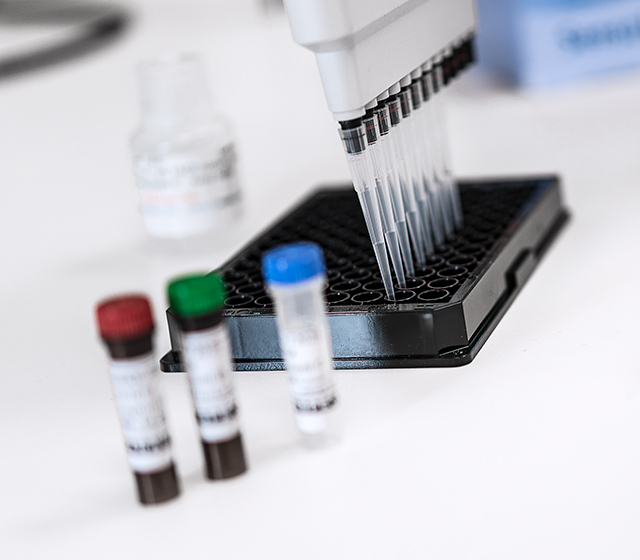Epigenetics
Sirtuin activity measurement
Our SensoLyte® Assay Kit provides a convenient, two-step homogeneous procedure for measuring sirtuin activity using a FRET or a fluorogenic substrate.
Epigenetic Processes: Histone Modifications
Histone proteins protect DNA from damage and play important roles in gene regulation and DNA replication. They are critical in the establishment of the nucleosome core particle, the most basic level of chromosome organization. There are five families of histones which are designated H1/H5 (linker histones), H2, H3, and H4 (core histones). Histones have essential structural and functional tasks in the transition between active and inactive chromatin states. Under the stimulation of various factors, such as metabolic states, diet, and specific small molecules, histones undergo posttranslational modifications that alter their interaction with DNA and nuclear proteins. These epigenetic processes are called histone modifications and the four most common include acetylation, methylation, phosphorylation and ubiquitination that change the three-dimensional structure of chromosomes and affect gene expression. Chromatin and histone post-translational modification have fundamental roles in gene regulation.
Histone Acetylation and Deacetylation
Covalent modification of histone proteins through acetylation and deacetylation affects chromatin structure and regulates gene expression.
Histone acetyltransferase (HAT) enzymes are a diverse group of proteins that are evolutionarily conserved from yeast to humans. Though HATs were originally identified as enzymes that acetylate histones and are involved in epigenetic regulation of gene transcription, a growing number of non-histone substrates have been detected for HATs. Lysine acetylation of transcription factors, such as c-MYC, p53, and NF-κB, have been shown to influence their promotor activities and specificities. HAT enzymes perform multiple functions in the cell, ranging from repairing regions of DNA damage to maintaining overall integrity.
The transcriptional co-activator p300 is a histone acetyltransferase that is typically recruited to transcriptional enhancers and regulates gene expression by acetylating chromatin. Mutations in the EP300 gene have been identified in several types of cancer. SensoLyte HAT (p300) Assay Kit Fluorimetric provides a convenient protocol for screening of enzyme inhibitors and for continuous assay of p300 activity.
Histone deacetylases (HDACs) are evolutionary conserved enzymes which act by deacetylation of histones and other protein regulatory factors, that result in chromatin remodeling and changes in gene expression profiles. HDACs play an important roles in physiological activities such as cellular homeostasis and development, and in pathological processes, such as cancer, neurodegenerative disorders and genetic diseases. The SensoLyte HDAC Activity Assay Kit Fluorimetric provides a convenient, two-step homogeneous procedure for measuring HDAC activity.
Deacetylation via SIRT
Sirtuins (SIRTs) 1 and 2 are signaling proteins that possess a deacetylase activity (class III HDACs) and require NAD+ as a cofactor. The mammalian SIRTs vary in tissue specificity, subcellular localization, enzymatic activity and targets. They deacetylate histones and several transcriptional regulators in the nucleus, as well as specific proteins in the cytoplasm and in mitochondria. Their biological functions vary from metabolism to cell survival and serve both as energy sensors and as transcriptional effectors. Sirtuins are involved in a range of diseases, such as diabetes, neurodegeneration and cancer.
SIRT1 is mainly localized in the nucleus, but also is present in the cytosol. Its activity is directly coupled with homeostasis and metabolism. SIRT1 controls the acetylation of FOXO transcription factors, the important regulators of lipid and glucose metabolism. Another target for SIRT1 is p53, which is deacetylated and repressed upon DNA damage or oxidative stress, resulting in impaired apoptosis. Disease-related functions of SIRT1 offer potential targets for the development of novel SIRT1-based therapies and identify SIRT1 as a target for anticancer therapy.
SIRT2 is expressed in a wide range of tissues and organs. It plays a critical role in transcriptional silencing. In response to DNA damage, SIRT2 deacetylates histone H3K56. Other functions include the regulation of microtubule acetylation, control of myelination nervous system, etc.
Our SensoLyte® SIRT Assay Kits provide a convenient, two-step homogeneous procedure for measuring sirtuin activity.
Protein Deubiquitination
Deubiquitinating enzymes (DUBs) are a large group of proteases that cleave ubiquitin from proteins. Ubiquitin is a highly conserved 76-amino acid polypeptide. Ubiquitination is a major player in regulating a broad number of cellular processes, including cell division, differentiation, signal transduction, and protein trafficking. Consequently, deubiquitinating enzymes play key regulatory roles in a multitude of activities from development, growth, to DNA repair and the pathogenesis of hereditary cancer to neurodegeneration. SensoLyte® Deubiquitination Assay Kits provide a convenient assays for the screening of enzyme inhibitors and activators or for continuous assay of deubiquitination activity.
FRET substrates
FRET occurs between a peptide tagged to a donor and an acceptor when placed within 10-100Å of each other resulting in the donor’s excitation fluorescence to be quenched by the acceptor. Enzymatic hydrolysis of the peptide results in recovery of the donor fluorescence following spatial separation of the donor and acceptor upon energy transfer.
| Dye (donor) | Quencher (acceptor) | Donor Ex/Em | |
| SensoLyte® 390 | Mca | Dnp |
•
325/393 nm |
|---|---|---|---|
| SensoLyte® 490 | EDANS | DABCYL |
•
340/490 nm |
| SensoLyte® 520 | 5-FAM or HiLyte™ Fluor 488 | QXL®520 |
•
494/521 nm |
| SensoLyte® 570 | 5-TAMRA | QXL®570 |
•
547/574 nm |
Fluorogenic substrates
These substrates do not require a quencher and contain a C-terminal dye that does not fluoresce until it is cleaved from the peptide (fluorescent form of dye is released).
| Dye (donor) | Donor Ex/Em | |
| SensoLyte® AMC | AMC |
•
351/430 nm |
|---|---|---|
| SensoLyte® AFC | AFC |
•
382/480 nm |
| SensoLyte® Rh110 | Rh110 |
•
501/527 nm |
